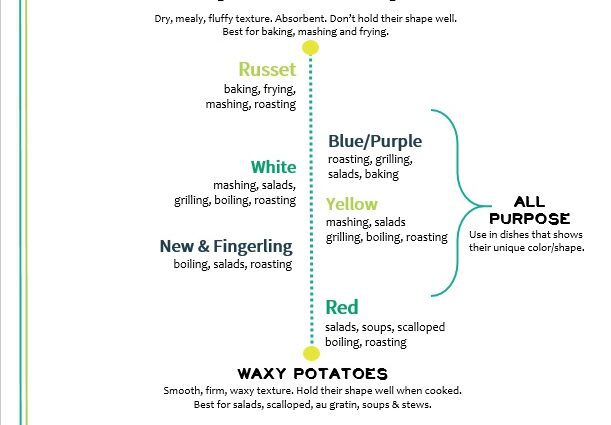Contents
How to choose the right potatoes?
Potatoes are among the most versatile foods. Many dishes are prepared from this. Many people buy potatoes without paying attention to the appearance, which leads to disappointment in their taste after cooking. The process of evaluating and memorizing the rules for choosing good tubers does not take long. Knowing a few tricks, anyone can determine which potatoes are best suited to the planned dish and will not harm their health.
What are potatoes
There are several thousand varieties of potatoes. Traditionally, all of its varieties are divided into groups that differ in three ways: the color of the tuber, the ripening period and the density of the pulp. It is these qualities that must be assessed when buying potatoes. Experts note that the shorter the ripening period of the tubers, the more their taste is disturbed. This happens by reducing the amount of starch in potatoes.
There is no consensus about which potatoes are the most delicious. Some people like crumbly tubers, others prefer hard varieties that retain their shape after boiling. Determining what the potatoes will look like after cooking is not difficult. First, you should pay attention to the variety and color of the peel.
Potato variety and cooking result:
- red varieties of potatoes after cooking do not become crumbly, but retain their shape;
- white types are boiled and are ideal for making mashed potatoes;
- yellow potatoes retain their shape after cooking, but inside they become soft.
There are rare varieties of potatoes with rich black, blue or purple hues. The flavoring qualities of these species differ. In this case, you need to remember two nuances:
- the brighter the color of the peel of the potato, the more useful components it contains;
- the richer the shade of the peel, the less boiled potatoes.
How to choose potatoes for cooking different dishes
The purpose of buying potatoes is a key consideration when choosing them. If tubers are purchased in small quantities and are intended for the preparation of a specific dish, then the selection process is carried out according to certain criteria. When buying potatoes in large quantities, it is not recommended to give preference to young tubers. Such varieties are not stored for long, so it is better to eat them immediately.
Secrets of choosing potatoes for different dishes:
- small potatoes of any dark shades are suitable for salads (they will retain their consistency after cooking and cook quickly);
- dark and yellow varieties of small size are ideal for potatoes “in their uniforms” (they will keep their shape and boil);
- pink potatoes are considered the best option for frying;
- large potatoes of white varieties are suitable for mashed potatoes (the absence of lumps in the mashed potatoes is guaranteed).
Experts note that potatoes boiled in their skins are considered the most useful, therefore, even for making salads, it is better to cook them in their skins. Young tubers are peeled by scraping or the skins are removed after boiling.
Which potatoes should or should not buy
Quite often, you can see potatoes on sale that do not differ in ideal shapes and even color. There are several rules that indicate that some tubers are not worth buying. If you do not pay attention to some of the nuances, then the potatoes will not only fail to meet expectations in terms of taste or consistency, but will also harm health.
Signs of poor quality potatoes:
- the presence of a green shade of the peel (usually spots) indicates the presence of an increased content of alkaloids, which in people with certain prerequisites can cause poisoning;
- brown spots on the peel, small holes and deep grooves on the peel indicate the influence of fungal microorganisms and beetles;
- if the surface of the potato is wet, then you should refuse to buy it;
- you should not buy potatoes with sprouts, they contain alkaloids;
- if, when trying to pierce the peel of a potato with a fingernail, moisture oozes out of it, then this is the first sign of nitrates that are harmful to human health.
Signs of a good potato:
- a firm surface free of sprouts and green spots;
- the presence of shallow eyes;
- smooth skin without scars and dents.
You can find washed and unwashed potatoes on store shelves. In this case, there is no difference which species to acquire, however, it will be difficult to consider all defects and evaluate it visually in the presence of a large amount of land. Clean potatoes are most often sorted when laid out on the counter, so the risk of low-quality root crops is excluded here.










